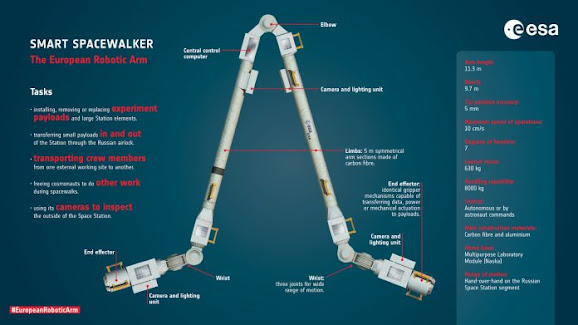During spacewalks, the last thing you need is legs: you just need an extremely talented arm alongside a mind, and eyes. Consequently, the European Space Agency has made an astute automated arm to work side by side with the space explorers outside of the International Space Station.
Spacewalks are not only excursions to take in the terrific view: they are expected to keep up with and update the station. In spite of the fact that space explorers partake in those novel minutes, which very few individuals have been fortunate to encounter, spacewalks are hard, dangerous, and here and there even wasteful in light of the outfit space explorers need to wear.
# A savvy and talented space arm
To see unequivocally what needs to be worked during spacewalks, researchers and specialists at ESA and the Dutch organization Fokker advances planned ERA: European Robotic Arm. Outfitted with one elbow, two wrists, four eyes, and a mind, it will secure itself outside the station and stretch and agreement in a worm-like style. In spite of the fact that it is a strong machine—nearly up to an eighteen-wheeler truck—its "hands" will perform fine engine assignments.
Time's various infrared cameras will offer an elevated perspective while performing quick and confounded developments and, simultaneously, getting close-up film.
Be that as it may, why infrared light eyes and not noticeable light ones like the human vision?
Matter discharges radiation yet, more often than not, objects are cold and can just emanate in the infrared. Wellsprings of noticeable light should be extremely hot or mirroring light from different sources. Infrared eyes will allow the robot to build a temperature guide of the station's surface, even on dim sides, stowed away from the sun.
Era will work either totally self-governingly, firmly directed by space explorers, or will be completely distantly controlled. It has a cerebrum, which implies that it will gain from its experience once it begins working in space.
Other than its superhuman faculties, it will move payloads and bring flesh spacewalkers around like a filtering out space crane.
# A totally new space lab with an arm
Time will not be the main automated arm working at the ISSInternational Space Station. The Canadian and Japanese modules as of now have automated arms to assist with docking vehicles coming from Earth. While the Russian section never required such help, since the Soyuz container moored itself, an examination module update has for quite some time been normal.
Along with the European mechanical arm, the Russian space organization Roscosmos will dispatch an altogether new Russian multipurpose lab module named Nauka. Nauka, which signifies "science" in Russian, will turn into the essential research facility on the Russian section.
Albeit principally worked for logical exploration, it will likewise fill in as a team quarters, assist with route, and force the station utilizing sun oriented energy.
Nauka has been anxiously anticipated since 2007. After a progression of specialized difficulties, it at long last showed up at Baikonur Cosmodrome in Kazakhstan. As per the last declaration, it is set to be dispatched on the 21st of July at 16:58 Central European Summer Time on a Proton-M rocket. The dispatch can be followed live with ESA Web TV and Roscosmos.
On the off chance that everything in the long run falls set up, it will dock at the old Zvezda module port at the ISS a couple of hours after its dispatch.
Space explorers can hardly wait to partake in their new module and work their new savvy contraption ERA. It addresses a further advance in human victories of room with the guide of machines.




0 Comments